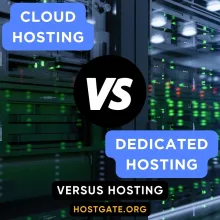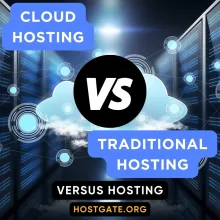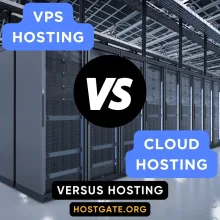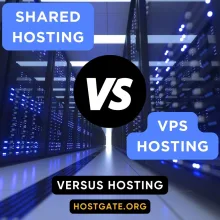Cloud Hosting vs Shared Hosting – Which One is Better? | HostingVS
Cloud hosting and shared hosting represent two distinct approaches to web hosting, each serving different needs. Shared hosting operates on a single server with divided resources among multiple websites, making it cost-effective and suitable for small websites and beginners. However, it comes with limitations in performance and scalability. Cloud hosting leverages multiple servers, offering superior performance, scalability, and reliability through distributed resources and automated failover systems.
While cloud hosting provides advanced security features, better performance, and unlimited scalability, it requires more technical expertise and potentially higher costs. Shared hosting offers simplicity and affordability but with limited resources and potential performance issues during traffic spikes. The choice between them depends on specific needs, technical expertise, budget constraints, and future growth plans, with cloud hosting being ideal for growing businesses and shared hosting suitable for smaller, stable websites.

 Experience the Most Affordable and Reliable Cloud Web Hosting Cloud Web Hosting Starting at Just $3.99/month! - Unlimited Storage & Traffic - Free Domain Included - 24/7 Expert Support - Dedecated & VPS Hosting Plans |
Cloud Hosting VS Shared Hosting | Cloud Hosting | Shahred Hosting |
Architecture & Resources | Cloud Hosting: Uses multiple interconnected servers; resources are distributed across a network of servers | Uses a single physical server; resources are shared among multiple websites |
Performance & Scalability | Handles traffic spikes efficiently | Fixed resource limits |
Reliability & Uptime | Automatic failover systems | Single point of failure risk |
Security & Management | Advanced security features | Basic security features |
Cost & Pricing Structure | Pay-as-you-go model | Fixed monthly/annual fees |
Cloud Hosting vs Shared Hosting: A Comprehensive Comparison
In today’s digital landscape, choosing the right hosting solution has become increasingly crucial for website success. The evolution of web hosting from simple file storage to sophisticated hosting architectures has created diverse options for businesses and individuals alike. Among these options, cloud hosting and shared hosting stand out as popular choices, each offering distinct advantages and limitations for different use cases.
The Fundamental Differences
The core distinction between cloud and shared hosting lies in their architectural approach. Shared hosting operates on a single server where multiple websites share resources, including RAM, CPU, and storage space. In contrast, cloud hosting leverages a network of connected servers, distributing resources and workload across multiple machines. This fundamental difference significantly impacts performance, reliability, and scalability capabilities of hosted websites.
Shared Hosting: The Traditional Approach
Shared hosting remains a popular choice for small businesses and personal websites due to its cost-effectiveness and simplicity. In this setup, multiple websites coexist on a single server, sharing all available resources. While this approach keeps costs down, it can lead to the “noisy neighbor” effect, where high traffic on one website affects the performance of others on the same server. Despite these limitations, shared hosting’s managed environment and straightforward setup make it an attractive option for beginners.
Cloud Hosting: The Modern Solution
Cloud hosting represents the evolution of web hosting technology, offering unprecedented flexibility and scalability. By utilizing multiple servers, cloud hosting provides better resource allocation, automatic failover capabilities, and improved performance through load balancing. The infrastructure includes sophisticated features like CDN integration, containerization, and various service models (IaaS, PaaS, SaaS), catering to diverse hosting needs from basic websites to complex applications.
Performance and Resource Management
Performance differences between these hosting types are significant. Cloud hosting excels in handling traffic spikes through dynamic resource allocation and load distribution across multiple servers. This results in consistently faster load times and better overall performance. Shared hosting, while adequate for low-traffic websites, can struggle during peak periods due to resource constraints. The ability to scale resources on-demand gives cloud hosting a clear advantage in performance-critical situations.
Reliability and Uptime Considerations
Reliability remains a crucial factor in hosting selection. Cloud hosting’s distributed architecture provides built-in redundancy, ensuring website availability even if individual servers fail. Automated failover systems and sophisticated backup mechanisms maintain continuous operation. While shared hosting providers typically offer decent uptime, they cannot match the robust reliability features of cloud hosting, particularly during hardware failures or maintenance periods.
Security Implementation and Compliance
Security implementations vary significantly between these hosting types. Cloud hosting typically offers advanced security features, including DDoS protection, automated malware scanning, and sophisticated firewall configurations. Additionally, cloud hosting providers often maintain various compliance certifications (GDPR, HIPAA), making them suitable for businesses with specific regulatory requirements. While shared hosting includes basic security features, its shared environment inherently poses more security risks.
Cost Structure and Resource Allocation
Pricing models reflect the fundamental differences between these hosting types. Shared hosting offers predictable, lower costs but with limited resources. Cloud hosting’s pay-as-you-go model can be more cost-effective for websites with variable traffic patterns, though it requires careful resource management to avoid unexpected costs. Hidden expenses like backup storage, bandwidth overages, and additional security features need consideration in the total cost calculation.
Business Applications and Scalability
Different business needs require different hosting solutions. Small businesses and personal blogs often find shared hosting sufficient for their needs, while growing enterprises typically require cloud hosting’s scalability and reliability. E-commerce platforms particularly benefit from cloud hosting’s superior security and performance features. The ability to scale resources instantly makes cloud hosting ideal for businesses expecting growth or experiencing variable traffic patterns.
Technical Management and Support
Management capabilities vary significantly between platforms. Cloud hosting provides sophisticated control panels and monitoring tools but requires more technical expertise to manage effectively. Shared hosting offers simpler management interfaces with less control but easier administration. Support levels also differ, with cloud hosting typically providing more comprehensive technical support options, though often at a higher cost.
Migration and Future Considerations
The decision to migrate between hosting types requires careful planning and consideration of future needs. While cloud hosting offers greater flexibility for future growth, the migration process can be complex and requires careful management to avoid service interruptions. Businesses should consider their growth trajectory, technical requirements, and resource needs when planning migrations between hosting types.
Conclusion
Both cloud hosting and shared hosting continue to serve important roles in the web hosting ecosystem. Cloud hosting offers superior performance, scalability, and reliability but requires more expertise and potentially higher costs. Shared hosting provides a simple, cost-effective solution for smaller websites with modest requirements. The choice between them should be based on specific needs, technical expertise, budget constraints, and future growth plans. Understanding these differences helps businesses make informed decisions about their hosting needs while considering both immediate requirements and future scalability.
Summary and FAQs
Which is more cost-effective: cloud hosting or shared hosting for a small business website?
Here’s a detailed breakdown:
Shared Hosting Cost-Effectiveness:
- Starting costs typically range from $3-15 per month
- Predictable fixed monthly/annual fees
- All-inclusive packages with essential features
- No hidden infrastructure costs
- Ideal for budgets under $200/year
Cloud Hosting Cost-Effectiveness:
- Starting costs typically range from $20-100+ per month
- Pay-as-you-go pricing model
- Resource-based billing
- Potential hidden costs for extra features
- Better value when traffic exceeds shared hosting limits
For Small Business Websites:
Shared Hosting is More Cost-Effective When:
- Your website has steady, predictable traffic
- Monthly visitors are under 10,000
- You’re just starting out
- Budget is a primary concern
- Basic features are sufficient
Cloud Hosting Becomes Cost-Effective When:
- Traffic is variable or growing rapidly
- You need guaranteed uptime
- Security is a top priority
- Performance cannot be compromised
- Business growth is expected
Important Considerations:
- Total Cost of Ownership (TCO)
• Shared hosting has lower TCO for basic websites
• Cloud hosting TCO varies with usage - Hidden Costs
• Shared hosting: Renewal rates, backup fees
• Cloud hosting: Bandwidth overages, additional features - Long-term Value
• Shared hosting: Fixed value proposition
• Cloud hosting: Scales with business growth
Recommendation:
For most small business websites starting out, shared hosting provides better cost-effectiveness. However, if your business:
- Processes online transactions
- Experiences seasonal traffic spikes
- Requires 99.9%+ uptime
- Handles sensitive data
Then cloud hosting might be more cost-effective in the long run, despite higher initial costs.
Consider starting with shared hosting and migrating to cloud hosting when your business outgrows the shared hosting limitations or when the need for advanced features justifies the additional cost.
Can I migrate from shared hosting to cloud hosting without downtime?
Here’s a comprehensive answer about migrating from shared to cloud hosting:
Is Zero-Downtime Migration Possible?
While complete zero-downtime migration is challenging, minimal downtime is achievable with proper planning. The actual downtime can be reduced to minutes rather than hours through careful execution.
Migration Process Breakdown:
Pre-Migration Steps
- Backup all website files and databases
- Audit current website resources and requirements
- Choose appropriate cloud hosting plan
- Document all configurations and settings
- Test website compatibility with new environment
Critical Migration Components
- DNS records transition
- Database transfer
- File system migration
- Configuration replication
- SSL certificate transfer
Minimizing Downtime Strategies
- Use temporary staging environments
- Implement DNS propagation properly
- Execute database synchronization
- Utilize migration tools and services
- Plan for off-peak hours migration
Common Challenges:
Technical Issues
- Database synchronization delays
- DNS propagation time
- Configuration mismatches
- Performance optimization needs
Potential Risks
- Data loss during transfer
- Temporary service interruption
- Configuration errors
- Security vulnerabilities during transition
Best Practices for Smooth Migration:
Planning Phase
- Create detailed migration checklist
- Set realistic timeframes
- Prepare rollback plan
- Test in staging environment
Implementation Phase
- Use professional migration services
- Monitor DNS propagation
- Keep original hosting active
- Verify all functionality post-migration
Professional Support Considerations:
Managed Migration Services
- Expert assistance available
- Reduced risk of errors
- Faster implementation
- Technical support throughout process
DIY Migration
- Requires technical expertise
- Higher risk of issues
- More time-consuming
- Cost-effective but challenging
Post-Migration Steps:
Verification
- Test all website functions
- Check email services
- Verify database integrity
- Monitor performance metrics
Optimization
- Fine-tune server settings
- Adjust resource allocation
- Update backup configurations
- Implement monitoring tools
The key to successful migration is thorough planning and proper execution, preferably with professional assistance to minimize potential issues and downtime.
How does security compare between cloud and shared hosting?
Here’s a detailed security comparison between cloud and shared hosting based on the latest information:
Cloud Hosting Security Features
Infrastructure Security
- Distributed server architecture
- Physical security in multiple data centers
- Isolated resource environments
- Regular hardware maintenance and updates
Advanced Protection
- Enterprise-level DDoS protection
- Real-time threat monitoring
- Automated malware scanning
- Advanced firewall configurations
- IP blocking capabilities
- Network monitoring tools
Compliance & Certifications
- GDPR compliance features
- HIPAA certification options
- PCI DSS compliance
- ISO certifications
- Regular security audits
Shared Hosting Security Features
Basic Infrastructure
- Single server environment
- Standard server security
- Shared resources between users
- Basic hardware protection
Standard Protection
- Basic DDoS protection
- Simple firewall configuration
- Shared SSL certificates
- Limited malware scanning
- Basic backup systems
Compliance
- Basic security certificates
- Limited compliance options
- Shared security protocols
- Standard SSL support
Key Security Differences
Resource Isolation
Cloud Hosting:
- Complete resource isolation
- Dedicated virtual environments
- No cross-contamination risk
Shared Hosting:
- Shared server space
- Resource overlap
- Potential security breaches from neighboring sites
Attack Prevention
Cloud Hosting:
- Multi-layer security
- Advanced threat detection
- Immediate threat response
- Multiple security checkpoints
Shared Hosting:
- Basic security layers
- Limited threat detection
- Reactive security measures
- Single security checkpoint
Backup & Recovery
Cloud Hosting:
- Automated backup systems
- Multiple backup locations
- Quick disaster recovery
- Regular backup testing
Shared Hosting:
- Basic backup options
- Single backup location
- Limited recovery options
- Manual backup processes
Security Risks
Cloud Hosting Risks
- Complex configuration requirements
- Higher attack visibility
- More sophisticated attack attempts
- Cost of security features
Shared Hosting Risks
- Vulnerable to neighboring site issues
- Limited security customization
- Shared IP address risks
- Basic security features only
Recommendation
Choose Cloud Hosting if:
- Handling sensitive data
- Requiring advanced security
- Needing compliance certifications
- Managing financial transactions
Choose Shared Hosting if:
- Running basic informational sites
- Working with limited budget
- Managing non-sensitive data
- Requiring basic security only
While both hosting types offer security measures, cloud hosting provides significantly more robust security features and better protection against modern cyber threats, making it the preferred choice for security-conscious businesses and websites handling sensitive information.
Which type of hosting is better for an e-commerce website?
Hosting Analysis for E-commerce Websites
Cloud Hosting for E-commerce
Advantages:
Performance & Scalability
- Handles traffic spikes during sales events
- Automatically scales resources during peak times
- Better load times for product pages
- Efficient handling of multiple concurrent users
- Seamless integration with CDN services
Security Features
- PCI DSS compliance for payments
- Advanced SSL/TLS encryption
- Regular security updates
- Robust data protection
- Secure payment processing capabilities
Reliability
- High uptime guarantees (99.9%+)
- Automatic failover systems
- Multiple server redundancy
- Consistent performance during high traffic
Shared Hosting for E-commerce
Limitations:
Performance Issues
- Limited resources during peak times
- Slower loading during sales events
- Fixed bandwidth allocation
- Shared resources affect speed
Security Concerns
- Basic security features
- Shared SSL certificates
- Limited PCI compliance options
- Vulnerable to neighboring sites
Scalability Restrictions
- Fixed resource limits
- Manual scaling required
- Limited growth potential
- Bandwidth constraints
Cost Comparison
Cloud Hosting
- Higher initial costs
- Pay-as-you-grow model
- Flexible resource allocation
- Better ROI for growing stores
Shared Hosting
- Lower initial investment
- Fixed monthly costs
- Limited resource packages
- Additional costs for upgrades
Recommendation for E-commerce Sites:
Choose Cloud Hosting If:
- Expecting significant growth
- Running medium to large stores
- Processing many transactions
- Requiring high security
- Managing large product catalogs
- Need seasonal scalability
Consider Shared Hosting If:
- Starting a small store
- Testing e-commerce concept
- Limited initial budget
- Small product catalog
- Low transaction volume
Key Takeaway:
Cloud hosting is generally better for e-commerce websites due to:
- Superior security for transactions
- Better handling of traffic spikes
- Scalability for growth
- Reliable performance
- PCI compliance features
- Professional security features
While shared hosting might work for very small or new e-commerce sites, cloud hosting provides the necessary features and scalability that most online stores need to succeed and grow in today’s competitive market.
Do I need technical expertise to manage cloud hosting?
Technical Requirements for Managing Cloud Hosting
Required Technical Knowledge
Basic Technical Skills Needed
- Server management fundamentals
- Command line interface usage
- Basic networking concepts
- Security protocol understanding
- Resource monitoring abilities
Advanced Skills for Optimal Management
- Load balancing configuration
- Database management
- Security implementation
- Performance optimization
- Scaling procedures
Management Areas Requiring Expertise
Server Configuration
- Operating system management
- Web server setup
- Database configuration
- Security settings
- Resource allocation
Maintenance Tasks
- Regular updates
- Security patches
- Performance monitoring
- Backup management
- Troubleshooting issues
Alternatives for Non-Technical Users
Managed Cloud Hosting
- Provider handles technical tasks
- 24/7 technical support
- Automated maintenance
- Expert management
- Higher cost but less expertise needed
Control Panel Solutions
- User-friendly interfaces
- Simplified management tools
- Automated tasks
- Visual resource monitoring
- Reduced technical requirements
Learning Curve
For Beginners
- 3-6 months to learn basics
- Start with managed solutions
- Focus on essential skills
- Use provider documentation
- Take advantage of support
For Experienced Users
- Quick adaptation period
- Advanced feature utilization
- Custom configuration options
- Performance optimization
- Security implementation
Cost Implications
Self-Managed
- Lower monthly costs
- Higher learning investment
- Potential mistake costs
- Time investment required
- Additional tool expenses
Managed Services
- Higher monthly costs
- Professional management
- Reduced risk
- Time-saving
- Expert support included
Recommendation
Choose Self-Managed If You:
- Have technical background
- Want complete control
- Have time to learn
- Can handle troubleshooting
- Want to minimize costs
Choose Managed Services If You:
- Lack technical expertise
- Need immediate solutions
- Focus on business growth
- Require reliable support
- Can afford higher costs
While technical expertise is beneficial for managing cloud hosting, it’s not absolutely necessary with managed services. However, understanding basic concepts will help you make better decisions and utilize your cloud hosting more effectively.





